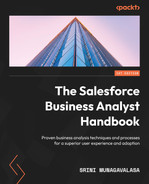Become a proficient Salesforce business analyst with the help of expert recommendations, techniques, best practices, and practical advice
Purchase of the print or Kindle book includes a free eBook in the PDF format. Salesforce business analysis skills are in high demand, and there are scant resources to satisfy this demand. This practical guide for business analysts contains all the tools, techniques, and processes needed to create business value and improve user adoption.
The Salesforce Business Analyst Handbook begins with the most crucial element of any business analysis activity: identifying business requirements. You’ll learn how to use tacit business analysis and Salesforce system analysis skills to rank and stack all requirements as well as get buy-in from stakeholders. Once you understand the requirements, you’ll work on transforming them into working software via prototyping, mockups, and wireframing. But what good is a product if the customer cannot use it? To help you achieve that, this book will discuss various testing strategies and show you how to tailor testing scenarios that align with business requirements documents. Toward the end, you’ll find out how to create easy-to-use training material for your customers and focus on post-production support – one of the most critical phases. Your customers will stay with you if you support them when they need it!
By the end of this Salesforce book, you’ll be able to successfully navigate every phase of a project and confidently apply your new knowledge in your own Salesforce implementations. This book is for intermediate- to senior-level business analysts with a basic understanding of Salesforce CRM software or any CRM technology who want to learn proven business analysis techniques to set their business up for success.Key Features
Book Description
What you will learn
Who this book is for
Table of Contents
- The Salesforce Business Analyst Handbook
- Contributors
- About the author
- About the reviewers
- Preface
- Part 1: Planning and Analysis – BRD/Prioritized Product Backlog
- Chapter 1: Identifying Requirements
- Chapter 2: Elicitation and Document Requirements
- Chapter 3: Prioritizing Requirements
- Chapter 4: Process Flows – “As-Is” versus “To-Be”
- Chapter 5: Business Requirements Document
- Part 2: Design, Development, and Testing – Iterative Cycles with Prototypes and Conference Room Pilots
- Chapter 6: Solution Design and Functional Document
- Chapter 7: Demonstrate Functionality Using Prototypes
- Chapter 8: Exploring Conference Room Pilots
- Chapter 9: Technical and Quality Testing
- Chapter 10: Requirements Traceability Matrix
- Part 3: End User Testing, Communication, Training, and Support
- Chapter 11: User Acceptance Testing
- Chapter 12: Communication and Knowledge Management
- Chapter 13: End User Training
- Chapter 14: Post Go-Live Support / User Forums
- Assessments
- Index
- Other Books You May Enjoy
